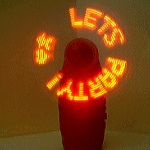
Stick Glow Size Chart
Flashing Blinky Lights...
Glow sticks (also called light sticks) are lots of fun. You can get glow sticks in many different colors (red, orange, yellow, green, blue, purple, pink, white, or aqua). You can get your glow sticks wrapped or unwrapped. Most glow sticks have a hook or clip at the end which can be used to hang the glow stick onto something.
Our lights sticks come in five sizes: 1.5 inches, 4 inches, 6 inches, 12 inches, and 15 inches. Glow sticks can either glow for a long time or brightly for a short time. The "burn time" depends on the formula that is used, on the length, on the fill level, on the color, and on the chemicals used. The glow times for each glow stick are listed at the top of each category or on the stick.
To activate your light stick, just bend the stick until you hear the stick make a popping sound. There are 2 liquids inside the stick. One liquid is inside of a glass ampule and that is what you hear "popping" when you bend the stick to activate it. The glow stick will start glowing when the two liquids mix together.
Glow sticks do not have an on/off switch. Once activated, the stick will glow until it burns itself out. It is possible to temporarily stop the glow by freezing the stick, but freezing will not rejuvenate the stick. When the stick thaws out, it will start back up where it left off. If there is any glow left when the stick is frozen, it will glow at the same level when it thaws out.
Flashing Blinky Lights...




























